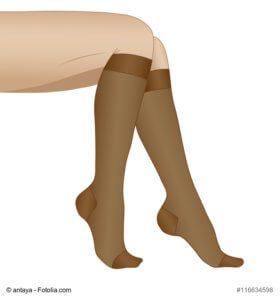When do you have to worry about DVT risk? Well, you develop deep vein thrombosis (deep vein thrombosis ()DVT) when a blood clot forms in one of your deep veins. (This usually occurs in your legs). And DVT is a serious problem, more dangerous than other blood clots. Why? Because it comes with a high risk of recurrence, death, or chronic symptoms like pain and
swelling.
But why do you develop DVT in the first place? Many factors contribute to this problem, but lack of movement is a big contributor (that's why your
DVT risk is high on long flights.) And, as we stayed home more, limiting our activity during the COVID-19 pandemic, that could be a problem. Even as COVID rates drop, the world has changed. Work from home will be much more common, and that's concerning in some ways. Especially if you already have
vein disease.
Thankfully, even taking a walk outside, and limiting your salty snacks, could help reduce your water retention and lower your DVT risk. Plus, we have several new and proven ways to treat your DVT. So just keep reading to learn more about what your life will look like, even if you develop a DVT.
New Microchip Predicts DVT Risk 
Researchers at Texas A&M University's College of Engineering have developed a miniaturized version a human vein called the Vein-Chip device. And they believe it will help doctors predict your DVT risk.
Basically, the Vein-Chip allows researchers to test various risk factors, including gender, race, ethnicity and more, to see how they impact DVT risk. The hope is that this technology will help our fellow vein specialists personalize your DVT treatment protocols.
Lead study author Abhishek Jain, Ph.D and his team have already made an important discovery that may impact post DVT treatment. Basically, they found that when you’re healthy, and your blood flow slows down, your body may try to adapt by releasing anti-clotting factors. This adaptation only happens within your vein pocket, which suggests that we should deliver clot dissolving medications directly to your affected areas.
That’s one exciting development in DVT prevention and treatment protocols. Because, with targeted anti-clotting therapy, we could prevent
dangerous bleeding episodes. So, now that we've discovered some new tech developments, let’s explore some other key findings.
What's the Best Treatment Plan after a DVT?
According to a study published in the journal
Blood, people with DVT can easily cut their risk of complications. How? It's simple: just start
compression therapy within 24 hours.

The study explored whether compression therapy could prevent residual vein occlusion and post thrombotic syndrome. What do those terms means? Residual vein occlusion is when clots stay in your veins, with or without symptoms. That's a big deal, since it likely contributes to post-thrombotic syndrome, which is just a collection of symptoms. These include pain, swelling, discoloration and leg scaling.
For this study, 600 DVT patients in the Netherlands received compression therapy within 24 hours of their diagnosis. Next, they were compared to patients that started that compression therapy later on. In addition to their compression therapy, all patients received anti-clotting medications.
What researchers found was promising: Patients who got immediate compression therapy were 20% less likely to develop residual vein occlusion and 8% less likely to suffer post-thrombotic syndrome compared with those who delayed compression.
Even better news? Compression therapy was not associated with any adverse side effects. And while all DVT patients appeared to benefit from compression, those with clots lower down in the leg enjoyed the greatest results.
Study author Dr. ten Cate-Hoek says, “Although the use of compression stockings after DVT is routine across much of Europe, it is less common in the United States, where guidelines emphasize compression primarily for patients who complain of ongoing symptoms…Given these outcomes, and that compression stockings are fairly easy to self-administer, relatively inexpensive, and minimally intrusive, compression therapy offers a clear benefit for all patients with DVT.”
Have you been diagnosed with DVT, and now you need to manage your care? Our Houston and Dallas area vein specialists are here to help.
Contact our office for an immediate appointment. We can help you protect your health with compression therapy, or any other treatments that may be necessary after we complete your evaluation.
Source Page: https://texaseva.com/sources/

 The study explored whether compression therapy could prevent residual vein occlusion and post thrombotic syndrome. What do those terms means? Residual vein occlusion is when clots stay in your veins, with or without symptoms. That's a big deal, since it likely contributes to post-thrombotic syndrome, which is just a collection of symptoms. These include pain, swelling, discoloration and leg scaling.
For this study, 600 DVT patients in the Netherlands received compression therapy within 24 hours of their diagnosis. Next, they were compared to patients that started that compression therapy later on. In addition to their compression therapy, all patients received anti-clotting medications.
What researchers found was promising: Patients who got immediate compression therapy were 20% less likely to develop residual vein occlusion and 8% less likely to suffer post-thrombotic syndrome compared with those who delayed compression.
Even better news? Compression therapy was not associated with any adverse side effects. And while all DVT patients appeared to benefit from compression, those with clots lower down in the leg enjoyed the greatest results.
Study author Dr. ten Cate-Hoek says, “Although the use of compression stockings after DVT is routine across much of Europe, it is less common in the United States, where guidelines emphasize compression primarily for patients who complain of ongoing symptoms…Given these outcomes, and that compression stockings are fairly easy to self-administer, relatively inexpensive, and minimally intrusive, compression therapy offers a clear benefit for all patients with DVT.”
Have you been diagnosed with DVT, and now you need to manage your care? Our Houston and Dallas area vein specialists are here to help. Contact our office for an immediate appointment. We can help you protect your health with compression therapy, or any other treatments that may be necessary after we complete your evaluation.
The study explored whether compression therapy could prevent residual vein occlusion and post thrombotic syndrome. What do those terms means? Residual vein occlusion is when clots stay in your veins, with or without symptoms. That's a big deal, since it likely contributes to post-thrombotic syndrome, which is just a collection of symptoms. These include pain, swelling, discoloration and leg scaling.
For this study, 600 DVT patients in the Netherlands received compression therapy within 24 hours of their diagnosis. Next, they were compared to patients that started that compression therapy later on. In addition to their compression therapy, all patients received anti-clotting medications.
What researchers found was promising: Patients who got immediate compression therapy were 20% less likely to develop residual vein occlusion and 8% less likely to suffer post-thrombotic syndrome compared with those who delayed compression.
Even better news? Compression therapy was not associated with any adverse side effects. And while all DVT patients appeared to benefit from compression, those with clots lower down in the leg enjoyed the greatest results.
Study author Dr. ten Cate-Hoek says, “Although the use of compression stockings after DVT is routine across much of Europe, it is less common in the United States, where guidelines emphasize compression primarily for patients who complain of ongoing symptoms…Given these outcomes, and that compression stockings are fairly easy to self-administer, relatively inexpensive, and minimally intrusive, compression therapy offers a clear benefit for all patients with DVT.”
Have you been diagnosed with DVT, and now you need to manage your care? Our Houston and Dallas area vein specialists are here to help. Contact our office for an immediate appointment. We can help you protect your health with compression therapy, or any other treatments that may be necessary after we complete your evaluation.